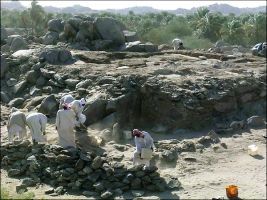Dam up the Nile to benefit poverty-stricken Sudanese
Jan 29, 2006 (KHARTOUM) — Stretching nearly 10 km across the River Nile in northern Sudan’s Merowe town, some 350 km north of capital Khartoum, a huge hydropower dam project was under construction.
 Hundreds of cranes, bulldozers and trucks have been mobilized to the construction site of the massive site of more than 20 sq. km. Amid thickly-dotted steelworks, thousands of workers, either Sudanese or Chinese, were busy working on the cofferdam. Although it was one of the most bearable days in the torrid lands of Sudan,workers still had to brave frequent sandblasts blowing up in the winds from the Nile.
Hundreds of cranes, bulldozers and trucks have been mobilized to the construction site of the massive site of more than 20 sq. km. Amid thickly-dotted steelworks, thousands of workers, either Sudanese or Chinese, were busy working on the cofferdam. Although it was one of the most bearable days in the torrid lands of Sudan,workers still had to brave frequent sandblasts blowing up in the winds from the Nile.
“It is the biggest dam project in Sudan, and even in Africa,” said Yang Zhong, deputy managing director of the contractor, at the earth embankment on the river bank.
In June 2003, a Chinese group signed a 650 million U.S. dollarscontract with the Sudanese government to build the Merowe Dam, Sudan’s biggest hydropower project, with an installed capacity of 1,250 MW, almost twice of the current grand total installed capacity of Sudan.
The Chinese CCMD joint venture, made up of the China International Water & Electric Corporation and Sinohydro Corporation (formerly China National Water Resources and Hydropower Engineering Corp.), has beaten world-renowned construction contractors to win the bid.
From June 2003 to the end of 2005, according to Yang, over 1,800 Chinese staff and workers have been mobilized to the Merowe site, and nearly 1,600 local workers have been employed.
Yang told Xinhua that on December 31 last year, they successfully finished the river closure work, the second stage of the whole construction process. The dam is scheduled to be completed in July 2008.
“Till then a dam of over 10 km, one of the longest in the world,will bestride on the River Nile,” Yang said, “I feel very proud that we Chinese can build this multi-purpose dam of power generation and irrigation for the Sudanese people.”
“I’m happy to work here,” said a Sudanese worker named Yusuf, “I know the dam will bring us benefit. It is a good thing.”
MAKE THE BEST OF THE NILE
The largest country in Africa bestowed with rich natural resources, Sudan remains one of the poorest countries in the world,with widespread poverty and fragile economic base.
The world’s longest river whose two branches meet in the country didn’t make it flourish. A large proportion of the population lives on less than one dollar per day and the annual per capita income is only around 530 dollars.
The power scarcity in many parts of the country, including in key industrial and agricultural zones which are the pillars of theeconomy, coupled with more than two decades of civil war have been blamed for holding up development in Sudan. In January last year, the Khartoum government and the main rebel group in the south signed a peace agreement which ended the long-running war and set the stage for massive reconstruction and development in many partsof the country.
Much of the country’s supply of electricity currently comes from the Roseiries Dam on the Blue Nile in eastern Sudan, but its capacity and age has meant that power supply is intermittent in many areas. The Merowe Dam will produce some 1,250 megawatts of electricity, and eight transmission lines with a combined length of 1,760 km will connect it to the national grid via a station in Merowe.
Sudanese President Omar Al-Bashir has said that he expected the completion of the new dam to help in the fight against poverty across the country.
“Our battle against poverty starts from here,” Al-Bashir said during a visit to Merowe last year. “It is a dream to be able to construct such an edifice, which will yield twice the current generation of electricity in Sudan.”
Al-Bashir predicted that the dam, expected to be completed by 2008, will contribute to development efforts in the country by generating much-needed electricity for domestic use as well as for industrial and agricultural projects.
And according to Yang, with the dam’s bulky reservoir, more than 60,000 hectares of farmland could be irrigated through the long sluices, benefiting more than 3 million Sudanese.
By making the best of the Nile, the poverty-stricken Sudanese are now beginning to see more prospects for their future.
“Merowe Dam represents the end of poverty because it constitutes the real start of development in the country,” said Al-Bashir
(Xinhua)
